

Victoria
Tandfonline. Canada's Missing and Murdered Indigenous People and the Imperative for a More Inclusive Perspective. Mortifères ou vivifiantes ? Les chauves-souris vues par des Autochtones aux Philippines. Canada's treatment of Indigenous peoples fits the definition of 'genocide' Raphael Lemkin, who coined the word "genocide" in 1943, defined the term as the destruction of a nation or of an ethnic group through the “disintegration of the political and social institutions, of culture, language, national feelings, religion and the economic existence of national groups, and the destruction of the personal security, liberty, health, dignity and even the lives of the individuals belonging to such groups.”

Genocide is defined in the Genocide Convention as any of the following acts committed with intent to destroy, in whole or in part, a national, ethnical, racial or religious group, as such: (a) Killing members of the group; (b) Causing serious bodily or mental harm to members of the group; (c) Deliberately inflicting on the group conditions of life calculated to bring about its physical destruction in whole or in part; (d) Imposing measures intended to prevent births within the group; (e) Forcibly transferring children of the group to another group. Canada’s genocide of Indigenous peoples: Time for decolonisation - JusticeInfo.net. The National Inquiry into Missing and Murdered Indigenous Women and Girls found that an ongoing genocide of Indigenous peoples constitutes a root cause of the violence that is currently being perpetrated against Indigenous women and girls.
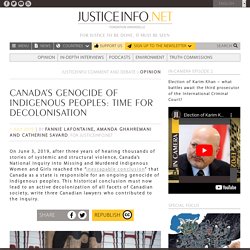
Genocide is a centerpiece of the National Inquiry’s report, which argues that colonial violence is ongoing, not just a legacy of the past. Its 231 Calls for Justice reflect the legal obligation to stop genocide through a range of policy and process changes. Indigenous women are at least six times more likely to be the victims of a homicide than non-Indigenous women. Numbers are difficult to ascertain, as they keep growing, but nearly two decades of studies and reports in Canada have uncovered more than 1,200 names of Indigenous women who are known to have been killed or who have simply disappeared.
Canada must not ignore Indigenous 'genocide', landmark report warns. Canadians can no longer turn a blind eye to the “genocide” of Indigenous peoples in the country, a landmark report on missing and murdered women has concluded.

Indigenous communities across the country have for decades attempted to convey the depth and scope of a tragedy that has haunted thousands of families. As many as 4,000 Indigenous women and girls are believed to have been killed or gone missing in Canada over the past 30 years – although the true number of victims is unlikely ever to be known. On Monday the findings of a three-year inquiry were released at a solemn ceremony in Quebec, attended by victims’ families, survivors, Indigenous leaders and senior government officials. “This is an uncomfortable day for Canada,” said the prime minister, Justin Trudeau. “We have failed you. “Reframing” Native Narratives: The Allure of Project 562. You’ve probably heard about Matika Wilbur by now (and if you haven’t, now is a good time to fix that!)
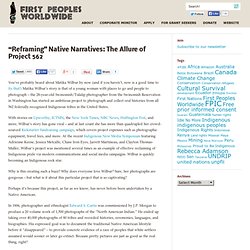
Matika Wilbur’s story is that of a young woman with places to go and people to photograph – the 28-year-old Swinomish/Tulalip photographer from the Swinomish Reservation in Washington has started an ambitious project to photograph and collect oral histories from all 562 federally-recognized Indigenous tribes in the United States. With stories on Upworthy, ICTMN, the New York Times, NBC News, Huffington Post, and more, Wilbur’s story has gone viral – and at last count she has more than quadrupled her crowd-sourced Kickstarter fundraising campaign, which covers project expenses such as photographic equipment, travel fees, and more.
Why is this creating such a buzz? Why does everyone love Wilbur? Sure, her photographs are gorgeous – but what is it about this particular project that is so captivating? The Residential School System. Children's dining room, Indian Residential School, Edmonton, Alberta.
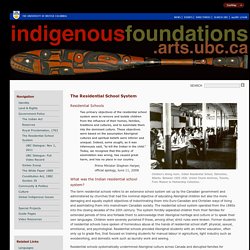
Between 1925-1936. United Church Archives, Toronto, From Mission to Partnership Collection. Impacts during and after life in a Residential School. "Residential school abuse survivors seek $1 billion in damages": Six Nations Public Library-Digital Archive. Residential school abuse survivors seek $1 billion in damages NORTH VANCOUVER - Survivors of abuse at native residential schools in British Columbia are seeking an estimated $1 billion in damages.
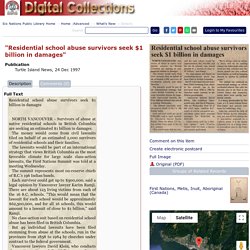
The money would come from civil lawsuits tiled on behalf of an estimated 2,000 survivors of residential schools and their families. The lawsuits would be part of an international strategy that views British Columbia as the most favorable climate for large scale class-action lawsuits, the First Nations Summit was told at a meeting Wednesday. The summit represents most on-reserve chiefs of B.C.'s 196 Indian bands. Each survivor could get up to $500,000, said a legal opinion by Vancouver lawyer Karim Ramji. No class-action suit based on residential school abuse has been filed in British Columbia. But 49 individual lawsuits have been filed stemming from abuse at the schools, run in the provinces from 1858 to 1984 by churches under contract to the federal government.
Reconciliation and Healthcare Trends. "Harper won't commit to TRC recommendations": Six Nations Public Library-Digital Archive. "Truth and Reconciliation Commission releases final report": Six Nations Public Library-Digital Archive. "Sides differ over preservation of residential school": Six Nations Public Library-Digital Archive. Sides differ over preservation of residential school MARIEVAL, Sask.
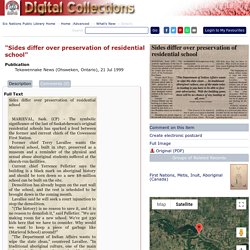
(CP) - The symbolic significance of the last of Saskatchewan's original residential schools has sparked a feud between the former and current chiefs of the Cowessess First Nation. Aboriginal boy before and after being forced into Canadian Residential School. Some schools had up to 60% mortality rate. : pics. Untitled. "Mohawk Institute": Six Nations Public Library-Digital Archive.